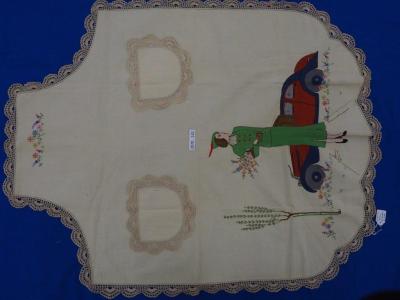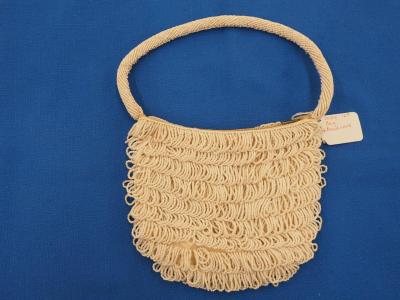STAMPED LINEN, APRON, CHILD
Calico aprons with stamped designs for hand embroidery, were popular in Australia in early 20th century.
The Great War 1914-1918 followed by the Great Depression, resulted in a shortage or fabrics and threads, calico aprons with stamped designs came to the fore for women and children. Designs of cottage gardens, Dolly Varden/Sun Bonnet Sue and crinoline lady were extremely popular in late 1920s to 1930s.
This child’s apron features Little Bo Peep with a sheep. Unworked, with a pocket separate.
The Great War 1914-1918 followed by the Great Depression, produced many changes in the lifestyles of women. With a shortage or fabrics and threads, calico aprons came to the fore.
In the 1930s, Semco, Melv, and Gautleys sold aprons on a 25 inch x 36 inch wide unbleached calico, ready to cut out, make up and embroider. Others were made up with design stamped ready to embroider. Mass-produced patterns became readily available and cheap pattern books such as Enid Gilchrist, covered aprons for every occasion.
Designs of cottage gardens, butterflies and swallows were popular, maybe implying that women were ready, or wished to get up and fly off. The Dolly Varden / Sun Bonnet / Crinoline lady image were extremely popular. Semco offered an alternative view of women, smartly dressed ‘modern women’ sometimes with hat and gloves, often wearing ‘red lipstick’.
During WWII social customs changed again. Resources were scarce. Calico aprons, at small financial outlay, cheered up women who longed for a little creativity and beauty. They became more than a mere accessory to prevent soiling of clothes. They enabled her to show her proficiency with the needle; may have served to hide any mend, tears or shortcomings of the dress due to scarcity of resources.
Details
Details
Embroiderers' Guild of WA Textile Museum
Embroiderers' Guild of WA Textile Museum
More items like this
Other items from Embroiderers' Guild of WA Textile Museum
Scan this QR code to open this page on your phone ->



